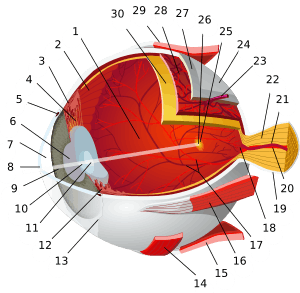Blood–ocular barrier
The blood–ocular barrier is a barrier created by endothelium of capillaries of the retina and iris, ciliary epithelium and retinal pigment epithelium.[1] It is a physical barrier between the local blood vessels and most parts of the eye itself, and stops many substances including drugs from traveling across it.[2] Inflammation can break down this barrier allowing drugs and large molecules to penetrate into the eye.[3] As the inflammation subsides, this barrier usually returns.
It consists of the following components:
- Blood-aqueous barrier: the ciliary epithelium and capillaries of the iris.[2]
- Blood-retinal barrier: non-fenestrated capillaries of the retinal circulation and tight-junctions between retinal epithelial cells preventing passage of large molecules from choriocapillaris into the retina.[4][5]
See also
- Blood–air barrier
- Blood–brain barrier
- Blood–retinal barrier
- Blood–testis barrier
- Blood–thymus barrier
References
- ↑ Peiffer, Robert L.; Petersen-Jones, Simon M. (2001). Small animal ophthalmology: a problem-oriented approach. Elsevier Health Sciences. p. 46. ISBN 978-0-7020-2570-9.
- 1 2 Kramer, Axel; Behrens-Baumann, Wolfgang (2002). Antiseptic prophylaxis and therapy in ocular infections: principles, clinical practice, and infection control. Karger Publishers. p. 72. ISBN 978-3-8055-7316-0.
- ↑ Giguère, Steeve; Prescott, John F.; Desmond Baggot, J. (2006). Antimicrobial therapy in veterinary medicine. Wiley-Blackwell. p. 366. ISBN 978-0-8138-0656-3.
- ↑ Coscas, G.; Cunha-Vaz, J.; Loewenstein, A.; Soubrane, G. (2010). Macular Edema: A Practical Approach. Karger Publishers. p. 59. ISBN 978-3-8055-9434-9.
- ↑ Maggs, David J.; Miller, Paul E.; Ofri, Ron; Slatter, Douglas H. (2008). Slatter's fundamentals of veterinary ophthalmology. Elsevier Health Sciences. p. 455. ISBN 978-0-7216-0561-6.
This article is issued from Wikipedia - version of the 11/5/2016. The text is available under the Creative Commons Attribution/Share Alike but additional terms may apply for the media files.

